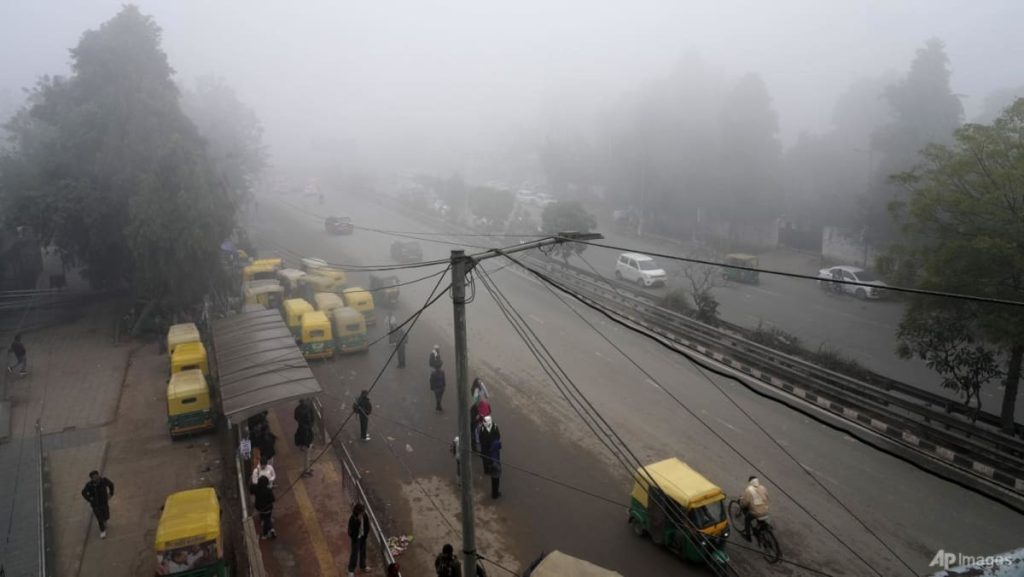The onset of winter in northern India, including the capital city of New Delhi, brought with it a dense blanket of fog and plummeting temperatures on Wednesday, January 15th. This severe weather significantly disrupted transportation networks, causing delays in both train and flight departures. The India Meteorological Department (IMD) responded to the deteriorating conditions by issuing an orange alert for Delhi, the second highest warning level, indicating the seriousness of the fog and its potential impact on daily life. The alert cautioned residents about the expectation of dense to very dense fog across numerous areas within the city and surrounding regions.
The fog’s impact was immediately felt at Delhi’s Indira Gandhi International Airport, a major aviation hub handling approximately 1,400 flights daily. Visibility plummeted to near zero, ranging from zero to a mere 100 meters, creating hazardous conditions for aircraft operations. Airport authorities, utilizing the social media platform X (formerly Twitter), issued warnings about potential flight disruptions, particularly for aircraft not equipped with the CAT III Instrument Landing System (ILS). This advanced navigation system allows pilots to land safely even in conditions of extremely low visibility. Consequently, several departures were delayed, impacting both domestic and international travel. India’s largest airline, IndiGo, also took to social media to inform passengers about the potential for delays due to the challenging weather conditions.
The disruption extended beyond the airport, affecting ground transportation as well. Media reports indicated that over 40 trains across northern India experienced delays due to the thick fog, which reduced visibility on the railway tracks. Images circulating in local media depicted the challenging conditions faced by commuters, showing vehicles moving at a crawl along major highways, their headlights struggling to penetrate the dense fog. The cold weather further exacerbated the situation, with temperatures dropping to a chilly 7 degrees Celsius, prompting people to seek shelter indoors. The combination of fog and cold created a particularly challenging environment for those who relied on public transport or had to commute for work or other essential activities.
Adding to the woes brought on by the fog and cold, Delhi grappled with severe air pollution, ranking as the world’s most polluted city on January 15th, according to the live rankings published by Swiss air quality technology company, IQAir. The city recorded an Air Quality Index (AQI) of 254, categorized as “very unhealthy,” indicating a significant threat to public health. This high level of pollution further complicated matters for residents already contending with the challenging weather conditions, posing respiratory risks and exacerbating existing health issues. The poor air quality underscored the ongoing struggle Delhi faces in combating pollution, particularly during the winter months.
Delhi’s persistent air quality issues have been a recurring theme throughout the winter season. A confluence of factors contributes to this problem, including vehicular emissions, industrial activity, construction dust, and the burning of crop residue in neighboring states. The colder temperatures and stagnant air during winter exacerbate the situation, trapping pollutants close to the ground and creating a thick haze known as smog. This smog, combined with the dense fog, creates a dangerous cocktail that poses significant health risks to the city’s residents, particularly vulnerable groups like children, the elderly, and those with pre-existing respiratory conditions.
The combination of dense fog, cold temperatures, and severe air pollution created a trifecta of challenges for Delhi and surrounding areas in northern India. The disruptions to transportation, coupled with the health concerns posed by the poor air quality, highlighted the vulnerabilities of urban centers to extreme weather events and the urgent need for sustainable solutions to address air pollution. The situation serves as a stark reminder of the interconnectedness of environmental issues and their impact on daily life, emphasizing the importance of proactive measures to mitigate such challenges.

